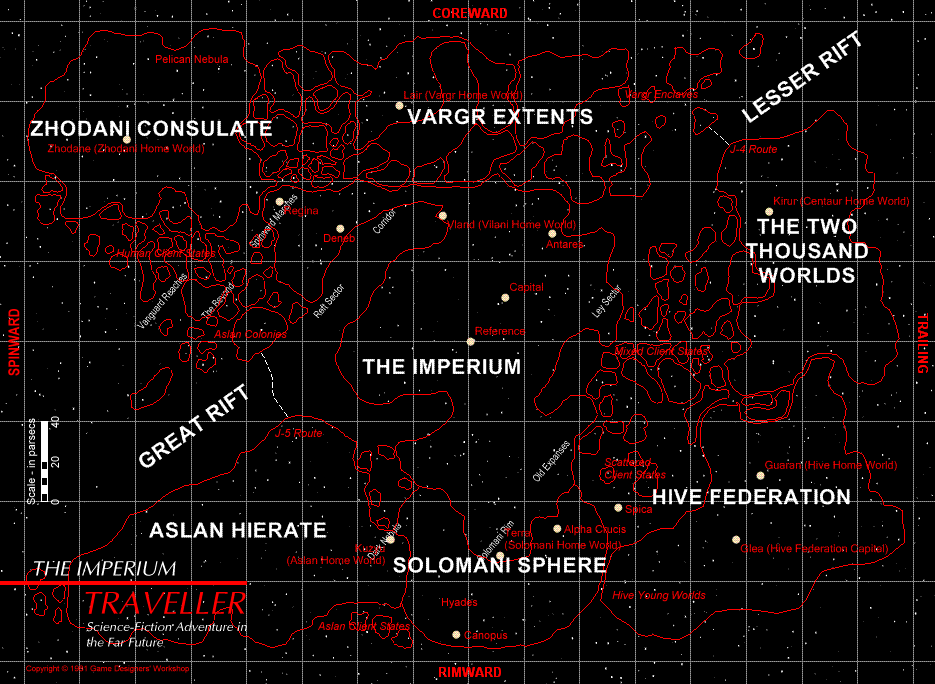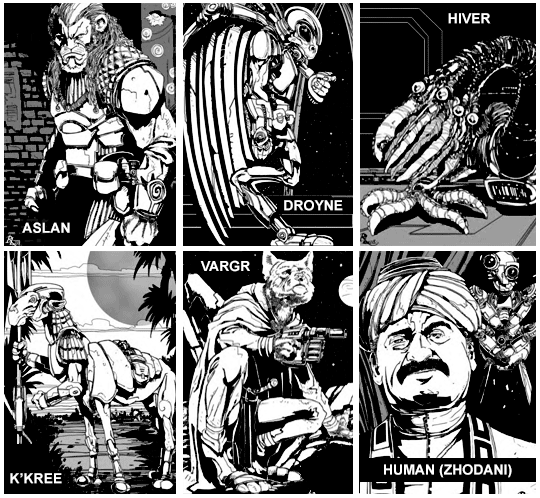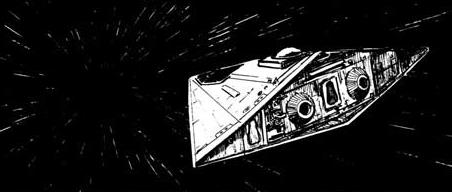Jan 5, 2023 7:48 pm
Our game takes place in the Third Imperium setting in the year 1115 (5,637 CE by Earth's calendar). The focal point of this setting is an intergalactic feudal empire founded by the humans from the planet of Vland. It has ruled a vast region of space for over a thousand years, with an unbridled focus on commercial and technological growth. Our travellers are all citizens of the Imperium.

Six Things to Know About the Third Imperium
1. Humans are everywhere: The first extraterrestrial beings that humans from Terra (Earth) encountered as the explored the stars were other humans. In fact, there are hundreds of worlds where humans developed independently, and humans are by far the most common species in the known universe. Genetic testing suggests all humans originate from Terra. Some of these humans are lost colonists from the early days of space exploration, but most were transplanted by long-forgotten aliens in prehistoric times for unknown reasons. This is one of the setting's greatest mysteries.
The Imperium itself does not originate from Terra, but from the planet of Vland and the Vilani people, who crossed the stars long before Terrans. There are two other large human interstellar empires: the Zhodoni Consulate and the Solomani Empire. In addition, there are hundreds of smaller clusters of worlds controlled by various groups. The word Humaniti is used to describe the collective of humans from all worlds.
2. There are lots of alien species: There are many kinds of intelligent aliens (sophonts) throughout the galaxy, although most do not control large interstellar empires. Thus, a Mos Eisley cantina scene would not be out of place in the Third Imperium. Some sophonts that do have large interstellar empires include the Vargr (uplifted Terran wolves), Aslan (lion-like Klingons), K'Kree (aggressively vegan centaurs), Hivers (six-fold radially symmetric beings that spread peace and love), and Droyne (a race of hexapod flyers with a mysterious past).

3. There is no Prime Directive: Unlike Star Trek, when primitive species are encountered they are not protected by any conventions, laws, or moral codes. As a result, the Third Imperium encompasses planets of different tech levels, ranging from the stone age to high interstellar technology. Although people from these worlds are considered citizens of the Imperium and are afforded all the rights and protections of all citizens, they may struggle to take advantage of its resources or be the victims of colonial exploitation.
While the Third Imperium is far from the utopia of Star Trek's Federation, neither is it evil like the Galactic Empire from Star Wars. It is much like modern nations of real life, driven by flawed humans in a morally grey universe.
4. Megacorporations dominate trade: A handful of massive corporations, some of which are older than the Imperium itself, dominate commercial trade. Their power rivals that of the ruling class, even the Emperor himself. Only on the frontier, where profits are too small for megacorporations to bother, is commerce still open to competition, although that is slowly changing.
5. Jump Drive allows people to travel between stars: The primary method FTL travel is the Jump Drive (J-Drive), which allows starships to travel through Jump Space to shorten the time to travel between two points in space. J-Drives are rated by a number between 1 and 6 (although more powerful drives are theoretically possible), which denotes how many parsecs a ship can travel in a single jump. Regardless of the distance travelled, a jump always takes 1 week of time.

6. No FTL Radios: Information cannot travel faster than starships. Therefore, communication across the stars must be carried by a ship. This creates significant lag between worlds. For example, if the Emperor were to die, the edges of the empire wouldn't find out about it for over half a year, assuming the fastest courier ships carried this message.

Six Things to Know About the Third Imperium
1. Humans are everywhere: The first extraterrestrial beings that humans from Terra (Earth) encountered as the explored the stars were other humans. In fact, there are hundreds of worlds where humans developed independently, and humans are by far the most common species in the known universe. Genetic testing suggests all humans originate from Terra. Some of these humans are lost colonists from the early days of space exploration, but most were transplanted by long-forgotten aliens in prehistoric times for unknown reasons. This is one of the setting's greatest mysteries.
The Imperium itself does not originate from Terra, but from the planet of Vland and the Vilani people, who crossed the stars long before Terrans. There are two other large human interstellar empires: the Zhodoni Consulate and the Solomani Empire. In addition, there are hundreds of smaller clusters of worlds controlled by various groups. The word Humaniti is used to describe the collective of humans from all worlds.
2. There are lots of alien species: There are many kinds of intelligent aliens (sophonts) throughout the galaxy, although most do not control large interstellar empires. Thus, a Mos Eisley cantina scene would not be out of place in the Third Imperium. Some sophonts that do have large interstellar empires include the Vargr (uplifted Terran wolves), Aslan (lion-like Klingons), K'Kree (aggressively vegan centaurs), Hivers (six-fold radially symmetric beings that spread peace and love), and Droyne (a race of hexapod flyers with a mysterious past).

3. There is no Prime Directive: Unlike Star Trek, when primitive species are encountered they are not protected by any conventions, laws, or moral codes. As a result, the Third Imperium encompasses planets of different tech levels, ranging from the stone age to high interstellar technology. Although people from these worlds are considered citizens of the Imperium and are afforded all the rights and protections of all citizens, they may struggle to take advantage of its resources or be the victims of colonial exploitation.
While the Third Imperium is far from the utopia of Star Trek's Federation, neither is it evil like the Galactic Empire from Star Wars. It is much like modern nations of real life, driven by flawed humans in a morally grey universe.
4. Megacorporations dominate trade: A handful of massive corporations, some of which are older than the Imperium itself, dominate commercial trade. Their power rivals that of the ruling class, even the Emperor himself. Only on the frontier, where profits are too small for megacorporations to bother, is commerce still open to competition, although that is slowly changing.
5. Jump Drive allows people to travel between stars: The primary method FTL travel is the Jump Drive (J-Drive), which allows starships to travel through Jump Space to shorten the time to travel between two points in space. J-Drives are rated by a number between 1 and 6 (although more powerful drives are theoretically possible), which denotes how many parsecs a ship can travel in a single jump. Regardless of the distance travelled, a jump always takes 1 week of time.

6. No FTL Radios: Information cannot travel faster than starships. Therefore, communication across the stars must be carried by a ship. This creates significant lag between worlds. For example, if the Emperor were to die, the edges of the empire wouldn't find out about it for over half a year, assuming the fastest courier ships carried this message.




